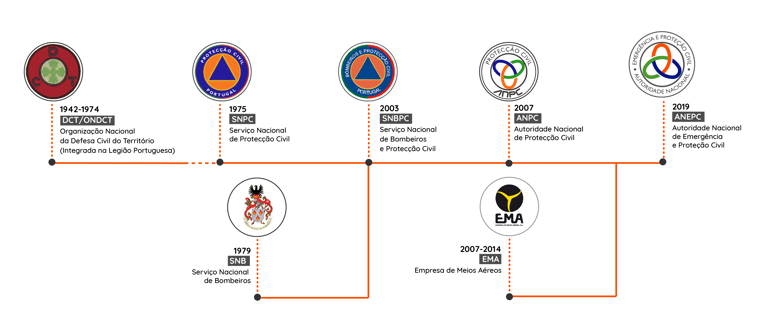History

The existence of a Civil Protection administrative authority in Portugal dates back to the New State, with the creation in 1942 of the Territory Civil Defence (DCT) within the Portuguese Legion. The DCT’s mission was to “ensure the regular functioning of national activities at times of war or severe emergency”. The principles and modus operandi of the National Organization for the Civil Defence of the Territory (ONDCT) were established in 1958, consolidating a permanent organic structure.
With the Revolution on 25 April 1974, on that same day, the Portuguese Legion is declared extinguished and, as a consequence, so is the ONDCT. In 1975 the National Civil Protection Service (SNPC) is set up under the Ministry of National Defence. Its aim is to “draft the protection measures, limit risks and minimize loss for the national civil population caused by natural disasters or emergencies due to the war, or anything that represents a threat or destruction of public or private goods and natural resources”. As of 1987, the CNEFF – National Specialized Commission on Forest Fires begins to operate with the SNPC.
The National Firefighter Service (SNB) is set up in 1979 under the Ministry of Home Affairs “with powers to guide and coordinate the relief activities and services provided by the firefighter corps and ensure their articulation with the National Civil Protection Service in the event of an emergency”. The SNB’s predecessors were the National Fire Services Council (1942) and the Coordinating Council for the Firefighter Service (1978).
The merger of these two bodies, the SNPC and the SNB in 2003 leads to the National Firefighter and Civil Protection Service (SNBPC). It sought to respond to the need for greater articulation between the bodies engaged in relief operations. It was tasked with preventing “risks inherent in the event of an accident, disaster, or calamity”, solving “the effects due to such events, protecting and assisting people and goods”, the guidance, coordination and supervision of the activities undertaken by the firefighters, and guidance and coordination of “all the protection and relief activities”. The Relief Operations National Centre and District centres were set up. It was established as the “national technical authority” for mainland Portugal, without prejudice of articulating with the firefighter and civil protection services of the Autonomous Regions of Madeira and the Azores.
As of 2006, an administrative modernization and reform of the civil protection system was begun. In this year, the Civil Protection Basic Law was approved, which references the creation of a National Authority for Civil Protection for the first time, as well as the new Ministry of Home Affairs organic law, which grants the Authority powers in risk prevention and management, emergency planning, protection and relief activity, and the firefighters’ activities.
In 2007, the National Authority for Civil Protection was set up through its own law, which sets its powers and organic structure. As a central service of an operational nature, its mission was to “plan, coordinate and enforce the civil protection policy, namely in the prevention of and reaction to serious accidents and disasters, protection and relief to the population and oversight of the firefighters’ activity”. The Firefighter Special Force was set up under its remit. In 2012 it included also the power preciously given to the National Council for Emergency Civil Planning. In 2013, its organic structure was amended again, and it absorbed the powers on aerial means and evolved towards becoming supra-district.
In 2014, the ANPC integrated the powers of the EMA – Empresa de Meios Aéreos (Aerial Means Enterprise), due to the fact it was extinguished. It had been set up in 2007 with the purpose of integrated management of the permanent aerial resources for public missions assigned to the Ministry of Home Affairs. The aerial means possessed by EMA are transferred to the State via the ANPC, which takes over them, and locating aerial means and hiring the technical and human resources allocated to them. As of 2017, under the reform of the management model for aerial means that are part of the Special Mechanism to Fight Wildfires – DECIR, the Air Force is entrusted with “the centralized command and management of the aerial means to fight wildfires using means owned by the State or others that are necessary in the season”, whereas the ANPC still defines the means that make up the mechanism.
In 2019, the National Authority for Emergency and Civil Protection takes over the ANPC with the added mission of “ensuring the planning and coordination of the national requirements in the field of emergency civil planning, with a view to responding to events of crisis or war”, and expressly taking on “the coordination of the civil protection agents”. The a Special Force for Civil Protection, the successor of the Firefighter Special Force is integrated in the AENPC’s structure, an intervention corps with their own command, specializing in protection and relief of the populations in the event of an emergency, serious accident or disaster, through preventive, response, support or recovery action. The creation of the ANEPC strengthened the Emergency and Civil Protection National Command’s capabilities, and changed the relationship model between the various levels of central, regional and sub-regional administration, where 18 District Commands transitioned to 5 Regional Commands and 24 Subregional Commands for Emergency and Civil Protection.